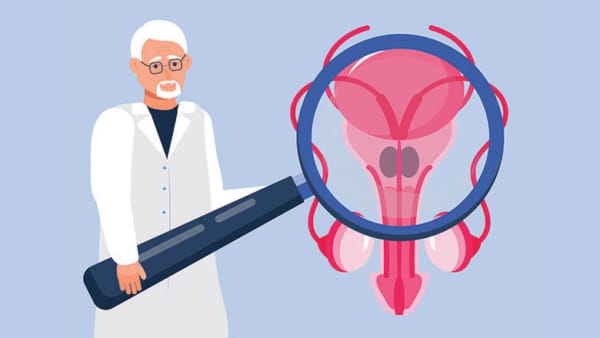Prostate Artery Embolization: A Non-Incision Option for Treating Enlarged Prostate or BPH
 If you repeatedly wake up at night to urinate because of an enlarged prostate but lose sleep over the thought of surgery, a revolutionary interventional radiology treatment might be your dream solution.
If you repeatedly wake up at night to urinate because of an enlarged prostate but lose sleep over the thought of surgery, a revolutionary interventional radiology treatment might be your dream solution.
The treatment, called prostate artery embolization (PAE), is an incision-free approach for benign prostatic hyperplasia (BPH) that works by preventing blood from reaching the enlarged prostatic tissue. Without blood to nourish and keep it alive, the tissue eventually shrinks.
The technique has gained widespread interest as a less-costly, less-invasive alternative to surgery. Favorable results for its success rates have further fed growing interest.
In this blog, we’ll review some of those research findings and whether PAE is a good option for you.
Reckoning With BPH: How to Know the Symptoms
Your prostate gland is only about the size of a walnut, but its position in your body – below the bladder and surrounding the urethra – gives it a big influence.
At around the age of 25, a man’s prostate enters a growth phase that continues throughout life. Eventually, the tissue can become large enough to compress the urethra, making it hard for the bladder to push urine out.
The risk of this occurring increases as you age: Half of all men have BPH by the time they are 60 years old, and 90% have it by age 85. As a result, BPH is the most common prostate condition among men older than 50.
Fortunately, BPH is non-cancerous, but because it might prevent the bladder from fully emptying, it can cause infections and other potentially serious conditions. Among the most common lower urinary tract symptoms (LUTS):
- Difficulty starting to urinate and/or straining to go.
- Being unable to empty your bladder fully.
- The sudden and more frequent need to go, day and night (nocturia).
- A weaker urine stream that may start and stop.
- Urinary leakage.
Should these symptoms persist for more than a few weeks, then it’s probably time to consult a urologist.
If your BPH symptoms are mild, your treatment will likely start with diet and behavioral modifications. Your doctor may also prescribe medications that can calm the prostate and bladder muscles or shrink the prostate tissue.
Prostate Artery Embolization: A Non-Drug, Non-Surgical Option
In cases where modification and medication do not relieve these LUT symptoms, doctors traditionally recommend removing the enlarged tissue using lasers, electrical currents, high-pressure water therapy, or by cutting the tissue away surgically.
(UroLift is another incision-free option, in which small, implanted devices pull the enlarged tissue away from the urethra, but it does not stop tissue growth.)
Prostate artery embolization offers an approach for patients who cannot or do not want to undergo surgery or procedures through the penis. Like some medications, it shrinks the prostate tissue and prevents growth, but without the medication side effects. It is performed in an outpatient setting.
Here’s how PAE is performed:
First, you will be placed under light sedation or twilight sleep. During the procedure, a specialist called an Interventional Radiologist (IR) uses X-rays to guide a slim catheter to your prostate through an artery in your thigh.
X-ray contrast is injected through the catheter to show the doctor the arteries feeding the prostate.
The IR physician then injects microbeads into those arteries, where the beads lodge and block blood flow to the enlarged tissue, causing it to shrink over time.
After the procedure, which lasts 45 to 90 minutes, you will require a couple of hours of rest. You might feel minor soreness in the groin, which will subside. Within three weeks, your LUT symptoms should begin improving.
More than 8 in 10 Men Feel Relief with PAE
Research shows PAE has a success rate of 85% to 90% and lasts an average of five to seven years.
One study shows an 85% success rate in the first year after the procedure, 82% success for up to three years, and more than 76% success from three to 6.5 years, the National Library of Medicine reports.
Another measure of PAE success is its lower rate of risk and side effects. For example, ejaculation impairment is less common in PAE patients than in surgery patients, according to Endovascular Today. PAE patients also are less likely to experience urinary incontinence or erectile dysfunction, studies find.
Finally, PAE is typically less expensive than other minimally invasive procedures, and most insurance plans cover it. (Men pay more than an estimated $1,500 each in individual costs for enlarged prostate treatment, studies find.)
Are You a PAE Candidate? Ask Your Doctor
Your eligibility for PAE depends on the degree of your BPH symptoms, which a urologist can pinpoint through a physical exam and diagnostic tests of your blood and urine, your urine flow, and your bladder function.
You can keep a record of your symptoms ahead of time by taking our BPH Symptom Quiz here.
If your BPH is advanced enough for surgery, you could be a candidate for PAE. Don’t lose any more sleep over it. Your prostate tissue will not stop growing until you make the decision to stop it.
If you have more questions about BPH, download our BPH educational booklet, which includes treatment pathways. You also can learn more about PAE treatment and watch our webinar here, and find out if you’re a candidate for PAE.

